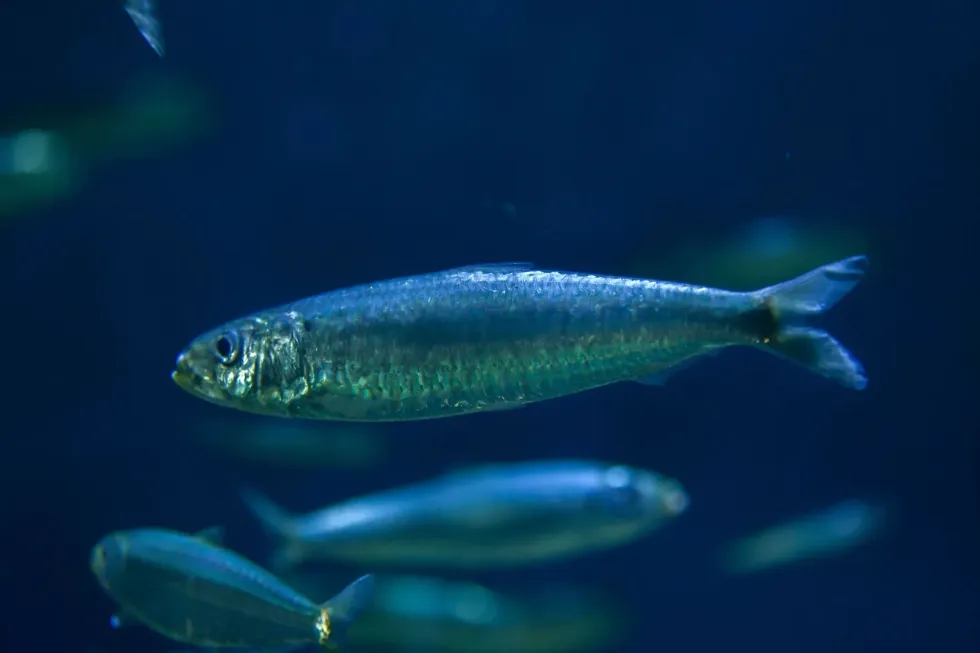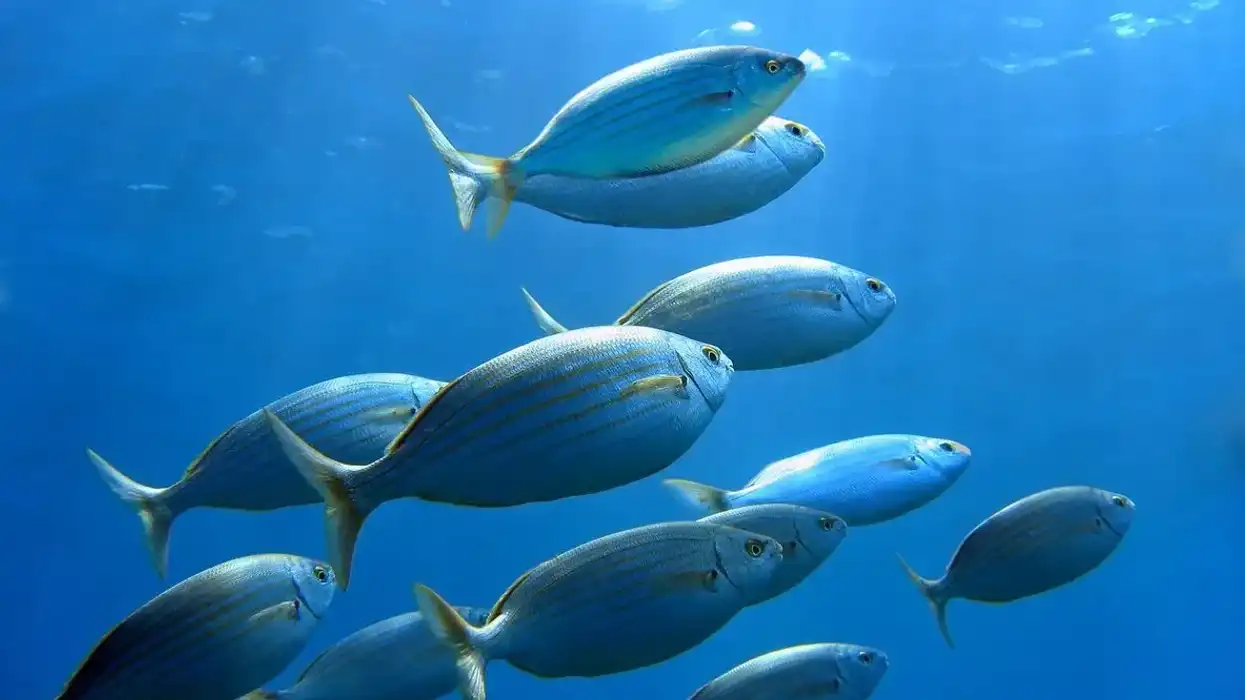European pilchards (Sardina pilchards) are a schooling, migratory, primarily coastal fish that occasionally ventures out to sea up to 62 mi (99.7 km). This fish is generally found at at depth range of 80-180 ft (24.3-54.8 m) during the day, although it can go as low as 330 ft (100.5 m).
These fish usually stay at a depth between 33-115 ft (10-35 m) beneath the surface at night.
This pilchard is common in the western half of the Mediterranean Sea and the Adriatic Sea but infrequent in the eastern portion and the Black Sea. When pilchards are around eight years old, they are completely developed, measuring a length of about 8.3 in (21 cm).
This sardine is highly valuable commercially.
A purse seine is the most common way of catching this species, but gill nets and other local fishing methods are sometimes utilized. N. Berry of Plymouth holds the UK rod-caught record for such species with the specimen weighing 0.49 lb (226 g).
The European pilchard is definitely an interesting species to read about, but as the saying goes, there are hundreds of fish in the sea! Check out our articles about the green sunfish and the scorpion fish.
European Pilchard Interesting Facts
What type of animal is a European pilchard?
This Sardina species is a type of fish.
What class of animal does a European pilchard belong to?
The European pilchard (Sardina pilchardus) belongs to the class of fish.
How many European pilchards are there in the world?
The population range of this species ,that can be found in various areas from the North Sea to the northeast Atlantic, is unknown. This is similar to lake trout which is eaten as food and considered a game fish species.
Where does a European pilchard live?
Sardina pilchardus live in the ocean at depths of 33-328 ft (10–100 m). You can find the European sardine in the northeast Atlantic, the Black Sea, and the Mediterranean Sea.
What is a European pilchard's habitat?
The range of European sardines stretches from Iceland through the southernmost parts of Norway and Sweden and Senegal in West Africa.
Who do European pilchards live with?
During the day, European sardines fish congregate in schools at a depth of 80-330 ft (24.3-100.5 m). In the winter, this sociable pelagic fish travels into the open ocean. In addition, a group of rainbow trout is known as a hover.
How long does a European pilchard live?
The European sardine (scientific Name Sardina pilchardus) lives for about five years in a favorable environment.
How do they reproduce?
Spawning begins in the winter, and youngsters, larvae, and adults travel to the shore in early spring. Over the course of a long breeding cycle, multiple bunches of eggs are produced. At around a year old and a length of 5.1-5.5 in (13-14 cm), most juveniles become sexually mature.
What is their conservation status?
This species found in the Black Sea and western part of the Mediterranean Sea is listed as Least Concern by IUCN. This is the same status as Pacific salmon, another type of fish we eat.
European Pilchard Fun Facts
What do European pilchards look like?
The pelvic fins originate much later than the dorsal fin, and the last two soft rays of the anal fin are bigger than the rest. The gill opening's hind edge is smooth and rounded in this species.
At the angle of the first-gill arch, the bottom gill rakers do not become shorter, and the upper series does not overlap the lowers ones.

* Please note that this is an image of the South American pilchard. If you have an image of the European pilchard, please let us know at hello@kidadl.com.
How cute are they?
A pilchard's cuteness is linked to their thin bodies and vibrant colors.
How do they communicate?
Sardines and pilchards are both good listeners. Sardines can perceive higher-pitched sounds than any other species, and their calls are inaudible among most aquatic predators.
How big is a European pilchard?
The average length of this sardine is about 4-8 in (10–20.3 cm). On the other hand, a red mullet measures up to 8-12 in (20.3-30.4 cm) in length. Therefore, the length of the red mullet is greater than the sardine.
How fast can a European pilchard swim?
A pilchard species can swim at speeds of up to 40 mph (64.3 kph).
How much does a European pilchard weigh?
The average weight of this sardine species, unique to the eastern part of the Mediterranean Sea, is about 2-3 oz (56.6-85 g).
What are the male and female names of the species?
Male and female fish of the European sardine species have no particular name. Adults breed near the shore and are caught in the Mediterranean by the lamp fishing method.
What would you call a baby European pilchard?
The baby of this pelagic sardine caught by different fishing methods does not have a special name.
What do they eat?
Sardina pilchardus fish prefer to feed at night. Therefore, European pilchard sardines generally remain close to the ground and feed towards the sea's surface.
Small planktonic crustaceans are the main food source for European sardines. However, they will also ingest food such as fish fry and immature fish. All varieties of predatory fish found in European waterways feed on pilchards, meaning they are an important food source.
Are they dangerous?
This Sardina pilchardus species, of the northeastern Atlantic Ocean extending from Norway and Iceland to Senegal, is not dangerous.
Would they make a good pet?
No, this sardine that is located along the northern shoreline of Africa, is not often kept as a pet. This species, in reality, is consumed by people and animals as a source of nutrition.
Did you know...
The Atlantic coast's American sardines are largely the juveniles of ordinary herring and menhaden. Sardius is a good example. Sardine and pilchard are popular names for various tiny, oily forage fish in the Clupeidae family of herring.
Sardines and herring are relatives of the herring family Clupeidae, containing anchovies, shad, and other oily, tiny schooling fish.
Sardine fish got their name from the island of Sardinia, where they used to be plentiful. In the United Kingdom, pilchard refers to a small saltwater fish that it can eat.
Where are pilchards from?
In the Mediterranean Sea or off the Atlantic coastlines of Spain, France, Portugal, and the United Kingdom, the European sardine (Clupea pilchardus or Sardina) is called a pilchard. Clupea harengus can be found all over the North Atlantic, including along the coasts of North America.
How does the European pilchard compare with similar fish?
The pilchard is one of a few small oily fish linked to herrings in the Clupeidae family. In contrast, the sardine is one of the several species of small herring, commonly preserved in olive oil or containers for food.
The pilchard or the European sardine is comparable to the Atlantic coast's American sardines. The juveniles of this species among the several fish that are commonly referred to as sardines.
Here at Kidadl, we have carefully created lots of interesting family-friendly animal facts for everyone to discover! For more relatable content, check out these lake trout facts and red mullet facts for kids.
You can even occupy yourself at home by coloring in one of our free printable icefishing coloring pages.










